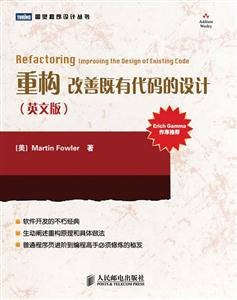目 录 Chapter 1: Refactoring, a First Example 1 The Starting Point 1 The First Step in Refactoring 7 Decomposing and Redistributing the Statement Method 8 Replacing the Conditional Logic on Price Code with Polymorphism 34 Final Thoughts 52 Chapter 2: Principles in Refactoring 53 Defining Refactoring 53 Why Should You Refactor 55 When Should You Refactor 57 What Do I Tell My Manager 60 Problems with Refactoring 62 Refactoring and Design 66 Refactoring and Performance 69 Where Did Refactoring Come From 71 Chapter 3: Bad Smells in Code (by Kent Beck and Martin Fowler) 75 Duplicated Code 76 Long Method 76 Large Class 78 Long Parameter List 78 Divergent Change 79 Shotgun Surgery 80 Feature Envy 80 Data Clumps 81 Primitive Obsession 81 Switch Statements 82 Parallel Inheritance Hierarchies 83 Lazy Class 83 Speculative Generality 83 Temporary Field 84 Message Chains 84 Middle Man 85 Inappropriate Intimacy 85 Alternative Classes with Different Interfaces 85 Incomplete Library Class 86 Data Class 86 Refused Bequest 87 Comments 87 Chapter 4: Building Tests 89 The Value of Self-testing Code 89 The JUnit Testing Framework 91 Adding More Tests 97 Chapter 5: Toward a Catalog of Refactorings 103 Format of the Refactorings 103 Finding References 105 How Mature Are These Refactorings 106 Chapter 6: Composing Methods 109 Extract Method 110 Inline Method 117 Inline Temp 119 Replace Temp with Query 120 Introduce Explaining Variable 124 Split Temporary Variable 128 Remove Assignments to Parameters 131 Replace Method with Method Object 135 Substitute Algorithm 139 Chapter 7: Moving Features Between Objects 141 Move Method 142 Move Field 146 Extract Class 149 Inline Class 154 Hide Delegate 157 Remove Middle Man 160 Introduce Foreign Method 162 Introduce Local Extension 164 Chapter 8: Organizing Data 169 Self Encapsulate Field 171 Replace Data Value with Object 175 Change Value to Reference 179 Change Reference to Value 183 Replace Array with Object 186 Duplicate Observed Data 189 Change Unidirectional Association to Bidirectional 197 Change Bidirectional Association to Unidirectional 200 Replace Magic Number with Symbolic Constant 204 Encapsulate Field 206 Encapsulate Collection 208 Replace Record with Data Class 217 Replace Type Code with Class 218 Replace Type Code with Subclasses 223 Replace Type Code with State/Strategy 227 Replace Subclass with Fields 232 Chapter 9: Simplifying Conditional Expressions 237 Decompose Conditional 238 Consolidate Conditional Expression 240 Consolidate Duplicate Conditional Fragments 243 Remove Control Flag 245 Replace Nested Conditional with Guard Clauses 250 Replace Conditional with Polymorphism 255 Introduce Null Object 260 Introduce Assertion 267 Chapter 10: Making Method Calls Simpler 271 Rename Method 273 Add Parameter 275 Remove Parameter 277 Separate Query from Modifier 279 Parameterize Method 283 Replace Parameter with Explicit Methods 285 Preserve Whole Object 288 Replace Parameter with Method 292 Introduce Parameter Object 295 Remove Setting Method 300 Hide Method 303 Replace Constructor with Factory Method 304 Encapsulate Downcast 308 Replace Error Code with Exception 310 Replace Exception with Test 315 Chapter 11: Dealing with Generalization 319 Pull Up Field 320 Pull Up Method 322 Pull Up Constructor Body 325 Push Down Method 328 Push Down Field 329 Extract Subclass 330 Extract Superclass 336 Extract Interface 341 Collapse Hierarchy 344 Form Template Method 345 Replace Inheritance with Delegation 352 Replace Delegation with Inheritance 355 Chapter 12: Big Refactorings (by Kent Beck and Martin Fowler) 359 Tease Apart Inheritance 362 Convert Procedural Design to Objects 368 Separate Domain from Presentation 370 Extract Hierarchy 375 Chapter 13: Refactoring, Reuse, and Reality (by William Opdyke) 379 A Reality Check 380 Why Are Developers Reluctant to Refactor Their Programs 381 A Reality Check (Revisited) 394 Resources and References for Refactoring 394 Implications Regarding Software Reuse and Technology Transfer 395 A Final Note 397 References 397 Chapter 14: Refactoring Tools (by Don Roberts and John Brant) 401 Refactoring with a Tool 401 Technical Criteria for a Refactoring Tool 403 Practical Criteria for a Refactoring Tool 405 Wrap Up 407 Chapter 15: Putting It All Together (by Kent Beck) 409 References 413 List of Soundbites 417 Index 419

















